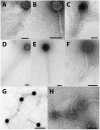Lysis to Kill: Evaluation of the Lytic Abilities, and Genomics of Nine Bacteriophages Infective for Gordonia spp. and Their Potential Use in Activated Sludge Foam Biocontrol
- PMID: 26241321
- PMCID: PMC4524720
- DOI: 10.1371/journal.pone.0134512
Lysis to Kill: Evaluation of the Lytic Abilities, and Genomics of Nine Bacteriophages Infective for Gordonia spp. and Their Potential Use in Activated Sludge Foam Biocontrol
Abstract
Nine bacteriophages (phages) infective for members of the genus Gordonia were isolated from wastewater and other natural water environments using standard enrichment techniques. The majority were broad host range phages targeting more than one Gordonia species. When their genomes were sequenced, they all emerged as double stranded DNA Siphoviridae phages, ranging from 17,562 to 103,424 bp in size, and containing between 27 and 127 genes, many of which were detailed for the first time. Many of these phage genomes diverged from the expected modular genome architecture of other characterized Siphoviridae phages and contained unusual lysis gene arrangements. Whole genome sequencing also revealed that infection with lytic phages does not appear to prevent spontaneous prophage induction in Gordonia malaquae lysogen strain BEN700. TEM sample preparation techniques were developed to view both attachment and replication stages of phage infection.
Conflict of interest statement
Figures



References
-
- de los Reyes FL III. 2010. Foaming p 215–258. In Seviour RJ, Nielsen PH (ed), Microbial Ecology of Activated Sludge. IWA Publishing, London.
-
- Klatte S, Rainey FA, Kroppenstedt RM. Transfer of Rhodococcus aichiensis Tsukamura 1982 and Nocardia amarae Lechevalier and Lechevalier 1974 to the Genus Gordonia as Gordona aichiensis comb. nov. and Gordona amarae comb. nov. Int J Syst Bacteriol. 1994; 44(4):769–73. - PubMed
-
- Lechevalier MP, Lechevalier HA. Nocardia amarae sp. nov., an Actinomycete Common in Foaming Activated Sludge. Nati J Syst Bacteriol. 1974; 24(2):278–88.
Publication types
MeSH terms
Substances
Associated data
- Actions
- Actions
- Actions
- Actions
- Actions
- Actions
- Actions
- Actions
- Actions
LinkOut - more resources
Full Text Sources
Other Literature Sources
Miscellaneous

